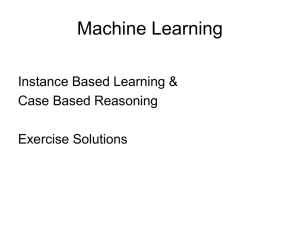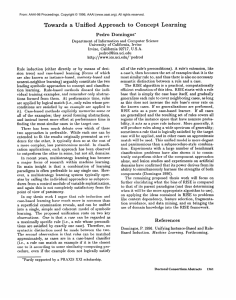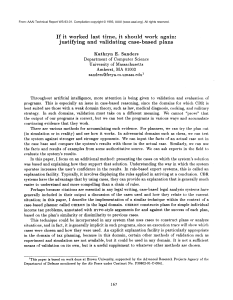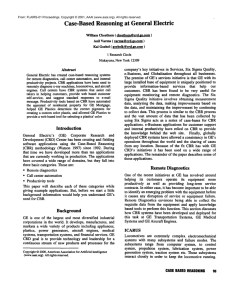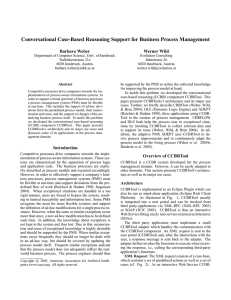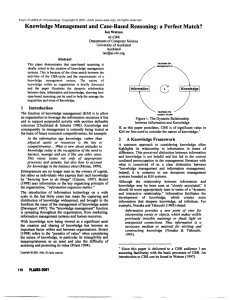Validating the Performance of a Case-Based Reasoning
advertisement
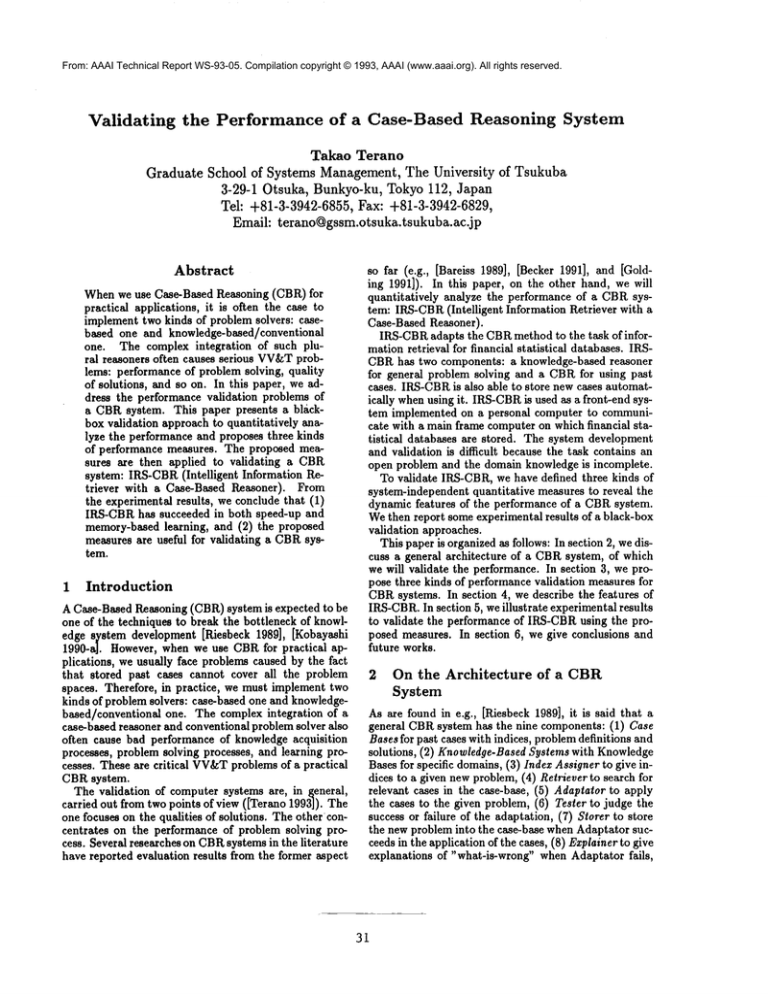
From: AAAI Technical Report WS-93-05. Compilation copyright © 1993, AAAI (www.aaai.org). All rights reserved. Validating the Performance of a Case-Based Reasoning System Takao Terano GraduateSchool of Systems Management, The University of Tsukuba 3-29-10tsuka, Bunkyo-ku,Tokyo112, Japan Tel: +81-3-3942-6855,Fax: +81-3-3942-6829, Email: terano@gssm.otsuka.tsukuba.ac.jp Abstract Whenwe use Case-Based Reasoning (CBR) for practical applications, it is often the case to implementtwo kinds of problem solvers: casebased one and knowledge-based/conventional one. The complex integration of such plural reasoners often causes serious VV~Tproblems: performance of problem solving, quality of solutions, and so on. In this paper, we ~ldress the performance validation problems of a CBRsystem. This paper presents a blackbox validation approach to quantitatively analyze the performance and proposes three kinds of performance measures. The proposed measures are then applied to validating a CBR system: IRS-CHR (Intelligent Information Retriever with a Case-Based Reasoner). From the experimental results, we conclude that (1) IRS-CBRhas succeeded in both speed-up and memory-basedlearning, and (2) the proposed measures are useful for validating a CBRsystem. 1 Introduction A Case-Based Reasoning (CBR)system is expected to one of the techniques to break the bottleneck of knowledge system development [Riesbeck 1989], [Kobayashi 1990-a[. However, when we use CBRfor practical applications, we usually face problemscaused by the fact that stored past cases cannot cover all the problem spaces. Therefore, in practice, we must implementtwo kinds of problemsolvers: case-based one and knowledgebased/conventional one. The complex integration of a case-based reasoner and conventional problemsolver also often cause bad performance of knowledgeacquisition processes, problem solving processes, and learning processes. These are critical VV&T problemsof a practical CBRsystem. The validation of computer systems are, in ~eneral, carried out from two points of view ([Terano 1993]). The one focuses on the qualities of solutions. The other concentrates on the performance of problem solving process. Several researches on CBRsystems in the literature have reported evaluation results from the former aspect 31 so far (e.g., [Bareiss 1989], [Becket 1991], and [Golding 1991]). In this paper, on the other hand, we will quantitatively analyze the performance of a CBRsystem: IRS-CBR(Intelligent Information Retriever with Case-Based Reasoner). IRS-CBRadapts the CBRmethodto the task of informationretrieval for financial statistical databases. IRSCBRhas two components: a knowledge-based reasoner for general problem solving and a CBRfor using past cases. IRS-CBK is also able to store new cases automatically whenusing it. IRS-CBR is used as a front-end system implemented on a personal computer to communicate with a main frame computeron which financial statistical databases are stored. The system development and validation is difficult because the task contains an open problem and the domain knowledgeis incomplete. To validate IRS-CBR,we have defined three kinds of system-independentquantitative measures to reveal the dynamic features of the performance of a CBP~system. Wethen report someexperimental results of a black-box validation approaches. This paper is organizedas follows: In section 2, we discuss a general architecture of a CBRsystem, of which we will validate the performance. In section 3, we propose three kinds of performancevalidation measuresfor CBRsystems. In section 4, we describe the features of IRS-CBR. In section 5, we illustrate experimentalresults to validate the performance of IRS-CBRusing the proposed measures. In section 6, we give conclusions and future works. 2 On the Architecture System of a CBR As are found in e.g., [Riesbeck 1989], it is said that a general CBRsystem has the nine components: (1) Case Basesfor past cases with indices, problemdefinitions and solutions, (2) Knowledge-BasedSystems with Knowledge Basesfor specific domains,(3) Index Assignerto give indices to a given newproblem,(4) Retriever to search for relevant cases in the case-base, (5) Adaptator to apply the cases to the given problem, (6) Tester to judge the success or failure of the adaptation, (7) Storer to store the new problem into the case-base whenAdaptator succeedsin the application of the cases, (8) Explainerto give explanations of "what-is-wrong" whenAdaptator fails, However, such an approach is CBR-system-dependent and very time-consuming. Onthe other hand, there is a black-box approachwithout analyzing the contents of the CBRsystem. For example, the relation of the numberof cases and the execution time shows the trade-off‘ between the numberof cases versus retrieving the cases. However,such simple data do not give the performance of each componentof a CBIt system shownin Fig. 1. Therefore, we will propose the system-independent quantitative measures to reveal the dynamicfeatures of the performanceof CBIt systems. These are Space Partition Ratio (SPK), Analogical Adaptation IL~tio (AAI~), and Reusable Case Ratio (RCR). To apply the measures, we assume that the CBRsystem can solve every given problem either using equipped problem solvers or assisted by the users, and that the characteristics of a given new problem can be determined by the requirement specification. A practical application system must require the former assumptionand the latter is required to experimentally evaluate the system performance. and (9) Repairer to repair the causes of the failures in past cases. These components (3)-(9) are further divided the three categories: Classifier, ProblemSolver, and Learner. Classifier makes the characteristic of a new problemclear, and matchespast cases. Classifier corresponds to Index Assigner and Retriever. ProblemSolver with Modifier is used to solve a newproblem. Modifier mainly solves a new problem by modifying past problem solving results. ProblemSolver corresponds to Adaptator, Tester, Explainer, and Repairer. Learner is used to store the solved problemnto the case-base with adequate indices. Learner corresponds to Storer. Space Partition Ratio SPRis defined as the ratio of the maximumnumber of cases with the same kind of indices to the total number of cases in a case-base. SPIt shows the utility of indices of stored cases and the performanceof Learner. If SPIt is large, the learning mechanismor the wayto give proper indices is not adequate, thus, most given problems must be solved by the same adaptation methods. In such a case, if new problems are always stored in a case-base, the performanceof case retrieval becomesworse. Analogical Adaptation Ratio Figure 1. General Architecture of a Case-Based Reasoner AAIt is defined as the ratio of the time required to adapt someold cases to a given problem by analogy to the time required to solve the given problemwithout CBIt. a CBIt system requires various adaptation knowledgeto apply the cases to new problems. AARshows the performance of the modification function of stored cases to a new problem. When the CBRsystem has no Learner, nor automatic case storing functions, AAtt also showsthe performance of the case-based reasoner. If AAIt is large, the adaptation mechanisms/knowledge should be improved. To develop the components(5), (6), (8), and (9), role of domainknowledgeis critical. The functions of ProblemSolver are attained by either case-based techniques or other knowledge-based ones. It is also difficult to implementthe components(3), (4), and (7) without domain knowledge. Thus, practical CBRsystems necessarily have both a case base and an implicit/explicit knowledgebase. The knowledgebase relys on empirical or model-based knowledgeto solve a new problem. Therefore, a general architecture of a CBRsystem should have the five componentsshownin Figure 1. In the succeeding sections, we assume that a CBRsystem has the architecture in Figure 1. 3 Performance Validation a CBR System Measures Reusable Case Ratio ItCit is defined as the ratio of the time to solve a new problem with the same indices of stored cases against the time required to solve the given problem without CBIt. ItCIt showsdirect usability of stored cases to a new problem. This can be used to evaluate the performanceof Classifier: the mechanisms of retrieving cases and case-base organization. If ItCIt is large, the case-base organization should be improved. for The best way to validate the performance of a CBRsystem is probably to analyze the CBRsystem componentwise, to statically measurethe size of case-bases, source codes, etc., and to dynamically evaluate the execution traces. This is a white-boxapproach for the validation. 32 4 Intelligent Information Retriever with a Case-Based Reasoner Background 4.1 To use financial statistical databases, users must handle multiple databases to get proper information. When we use multiple financial statistical databases, we must represent our requirements in proper technical terms; select proper databases which contain required information; and use specific retrieval commandsin each database. IRS-CBRis used as a front-end system implemented on a personal computer to communicate with a main frame computer on which financial statistical databases are stored. The tasks of IRS-CBR are interpretation and design [Kobayashi 1990-b] in the sense that IRS-CBRfirst analyzes the user’s shallow requirements; then translates them into the concepts of information retrieval; and generates concrete information retrieval commandsfor a specific database implicitly described in the requirements. The pre-requirements on the performance of IRS-CBR is to generate proper commandswithin one or two minutes on a personal computer, because it takes about three to six minutes to get information from databases on a main frame computer [Terano 1992]. 4.2 System Configuration and Functions IRS-CBR has two components: a knowledge-based reasoner for general problem solving and a CBRfor using past cases. IRS-CBRis also able to store new cases automatically. The system configuration of IRS-CBRis shown in Figure 2. The current version of IRS-CBR is implemented in Prolog. The case-base of IRS-CBRis simply organized. Each case is stored in the form of the predicate of Prolog language. Variables in the predicate correspond to the indices of the case. To retrieve the case-base, to generalize a new problem, and to translate the problem into the commands, IRS-CBR has five kind of knowledgebases: Synonym Dictionary, Concept Frames, Approximation Heuristics, Database Selection Heuristics, and Database Frames. These knowledge-bases can be interactively modified if necessary, while using IRS-CBR. In order to solve a new problem requested by the user, IRS-CBRutilizes past cases three times. If the adaptation of the cases fails, IRS-CBRtries to apply a knowledge-based system to solve the problem. Because the knowledge is incomplete, the system may also fail. In such a case, if the user has enough knowledge, the user can directly input the proper commandsto retrieve the databases. In each step, when successful, information retrieval commandsare generated and transferred to the main frame. The successfully solved cases are automatically stored into the case-base with generalized indices. The steps are as follows: (1) For a given requirement, IRS-CBR retrieves case-base to directly apply past cases. the (2) If unsuccessful in (1), the requirements are generalized using Synonym Dictionary in the knowledgebases in order to match the past cases. 33 Figure 2. System Configuration of IRS-CBR (3) If unsuccessful in (2), IRS-CBRtries to adapt multiple cases to the given problem, in which both Synonym Dictionary and Concept Frames in the knowledge-bases are used. (4) If unsuccessful in (3), IRS-CBRtries to convert the requirement into approximate ones using Approximation Heuristics in the knowledge-bases. If there are multiple candidates, IRS-CBR shows them to the user for selection. (5) IRS-CBR tries to generate information retrieval commandsfor the specific databases, which is attained by using Database Frames and Database Selection Heuristics. (6) If unsuccessful in (5), IRS-CBRrequires the user manually input proper information retrieval commands. the commands and communi(7) IRS-CBR generates cates with the main frame. At the same time, the user’s requirement is stored in the case-base as a successful case. (8) The user gets the retrieval frame. results from the main Figure 3 shows a typical performance graph of ItLSCBR. We must evaluate whether the performance is good or bad. The performance of IRS-CBR can be affected by various factors of the above steps. These are summarized in the following. The time for the step 1 linearly increases when the number of stored cases increase, because the case-organization mechanism is very simple. Each step 2 to 5 requires the constant time because the size of knowledge-bases and the inference steps are considered to be constant. The time for step 6 depends on the difficulty of the requirements and the expertise of the user. However, if the knowledge acquired in step 6 is accumulated as new cases, step 6 can be skipped. Step 7 and 8 definitely dependson the database retrieval and communication time in a main frame computer. The time should be omitted from the validation. 8O gila- IT - ~ i i--, i---t-,i,,~; .... -~ , ~i ...........:-30 ’~" i -. 80 P"................. - 50 70 ............................ 60 50 ......... are selected not to be applicable in the following processes so that all are stored in the case-base after processing. The result indicates the utility of SPR. Experiments (III): Requirements without problem solving knowledge The objective is to evaluate the performance of knowledge acquisition functions of IRS-CBR. We have changed the requirements by manually input commands.In such a case, IRS-CBRhas no problem solving knowledgein the knowledge-bases, so that we can estimate the knowledgeacquisition capability by measuring the processing time whenthe cases are accumulated.The result also indicates the utility of RCR. 3040......__ ~11 L Lw= o. 20 16 0 ~! ....................... Illl !..,.,_.._,......~ lilIilliliIH - 2O i-lt - 1o II’" "": "’-ii~ Ill II iHI IH= 0 .... Number of Problems :~’ Number of Cases Figure 3. Typical or B0 8O ,e, Processing Time(sec.) Performance 5.2 Experimental Results 5.2.1 Results when cases are available unavailable of IRS-CBR 70 ~- 5O 8o -4o 5 Validating IRS-CBR the Performance Z-3o .~, 4o of 2O 0. 20 To validate the effectiveness of the proposed measures and IRS-CBR,we have performed intensive experiments on IRS-CBRfrom quantitative standpoints. I0 10 0 0 0 on IRS-CBR 5.1 Experiments The original user interfaces are menu-driven ones and designed for manualinput. The interface maycause the disturbance for measuring time. Thus, we have developed special input interfaces, whichread user’s requirements from files. Wehave also removedthe main frame interface, because it will becomehard to estimate the performanceif it exists. Thereremains the user interface for step 6 in the previous section, becausethere is no way to acquire such kind of knowledgewithout the interface. Wehave prepared 60 typical user’s requirements. With these preconditions, we have carried out the following experiments on the performance evaluation. ¯ Experiment (I): Whencases are available or unavailable To evaluate the performance of the case adaptation function, we consider the following situations: One is that there are someinitial cases in the case-base which are applicable to user’s requirements. The other is that there are also someinitial cases in the case-base, however,they cannot be applied to user’s requirements. The utility of AAR is estimated from the experiment. ¯ Experiment (II): Different requirements This is to evaluate the performance improvement using cases and the performance defect by accumulating cases. In the experiment, the requirements 34 5 10 15 20 25 30 35 40 45 50 55 60 Number of Problems Number of Cases Figure .o, Processing Time(see.) 4. Performance of IRS-CBR When Cases are Available Figure 4 showsthe performanceresults whencases are available. Fromthe figure, it takes about 16 seconds to process a normalnew requirement if there exist applicable cases. The normal requirements are processed from step 1 or 2 (Classifier) in the previous section. Wehave 3 abnormal requirements here, in which the contents of Concept Frames are modified manually. On the other hand, Figure 5 shows the performance whencases are unavailable. From the figure, it takes about 42 seconds to process a new requirement. It take muchmore time than the results of Figure 4, because the steps 1 to 5 for knowledge-basedproblemsolving are all executedin this case. From the two experiments, we find Analogical Adaptation Ratio (AAR)is equal to 0.38. This suggests that CBRin IRS-CBRis effective to improve the problem solving performance. 5.2.2 Results for different requirements Figure 6 shows the performanceresults for different requirements. In case 1, it takes 41 seconds to process the requirement, because steps 1 to 5 are all executed in this case. Sameas the previous results, cases processing taken over 60 seconds are abnormal ones, in which the contents of Concept Frames are modified manually. 6O 5O ~9 - 40 ,~ 20 10 o Number of Problems .~ Number of Cases Figure 180 180 ii =e 120 ." 40 Iv- 100 .’-- 30 ~’ 80 :- 20 60 .... ,r 4010 20:-0 00 5 10 15 20 25 30 35 40 45 50 ~ ProcessingTime(see.) Number of Problems 5. Performance of IRS-CBR When Cases are Unavailable ",~ Number of Cases Figure ’ 80 70 60 50 illii 70 60 50 j .............................................. i ............... I 40 30 2O ........ i .........................~........ 20 10 0 ,~wll=,=l 0 5 10 ill, 15 1ill !J ,ll=lJlJ~ ~ee ~ iI lO ~lee le~e 0 2025 303540 455055 60 Number of Problems ,~ Number of Cases ~-so "~’ Processing Time(sec.) Figure 6. Performance of IRS-CBR for Different Requirements 35 41, Processing Time(sec.) 7. Performance of IRS-CBR without Problem Solving Knowledge As the organization methodof the case-base is simple, the processing time linearly increases when the number of cases are accumulated. Whenthe number of cases reaches 60, the processing time becomesthe same as in knowledge-basedsolver without the case-base. From the Figure 7, we can observe that there are two directions of processing time. This indicates that the requirements are classified into two groups with different kinds of indices. The ratio is 2:1. Thus, Space Partition Itatio (SPIt) is equal to 0.67. The result suggests that the case organization mechanism(Learner) should be modified to adapt the features of input problems. Results for the requirements without problem solving knowledge Figure 7 showsthe performanceresults for the requirements without problem solving knowledge.In the experiment, we have interpreted the requirements defining the new concepts. For example, the following is one of specific knowledgewhich can be hardly represented in conventional knowledge-based approaches: "The amount of Germany means the sum of the amounts of WestGermany and East-Germany." It usually takes muchmore time to process the requirements than the previous experiments, because the experiment requires manyuser interactions. Especially, in the case taken over 100 seconds to process, we have manually given the corresponding retrieval commands. However, after case 30, the performance becomesstable. The processing time also becomesalmost the same as shownin Figure 8. In the stable stages, therefore, memory-basedlearning or implicit empirical knowledge 5.2.3 acquisition are attained. This is observedfrom the value of RCRof the later stage of the experiment (RCRis equal to 0.14). effectiveness of the measures,wehave illustrated the results of quantitative experiments on the performanceof IRS-CBR. From the experimental results, we conclude that (1) 5.3 Discussion IRS-CBRhas succeeded in both speed-up and memorybased learning in a practical sense, and (2) the proposed The discussion on the experimental results must have two directions. The one is the performance of IRS-CBR. measuresare useful for the performanceevaluation of a CBRapplication. The other is the evaluation of the proposed measures. Directions for related future workinclude the applicaExperiments(I) and (II) have been carried out in tion of the proposed measures to various problems, and artificial conditions. Althoughthe experiment (I) has the exploration of validation measuresof solution quality shownprincipal benefits of CBRin IRS-CBR,the experof a CBRsystem. iment(II) has suggestedthe possibility of the worseperformance of the CBRcomponent. However, the experiments(III), whichhave been in the practical conditions, References have shown that we can succeeded in speed-up learn[Bareiss 1989] Bareiss, R.: Exemplar-BasedKnowledge ing for the problems usually required by the user, and Acquisition. AcademicPress, 1989. that memory-basedlearning for the problems in which [Becker 1991] Becker, L., Guay, T.: Measures for the the domainknowledgeis hardly represented in symbolic Evaluation of Case-Based Suggestion. Proc. Casemanner. In this sense, using CBRtechniques in the domain of IRS-CBR,the performance of the system have Based Reasoning Workshop’91, pp.170-178, 1991. been clearly improved. Therefore, we can conclude that [Golding 1991] Golding, A.R., Rosenbloom, P.S.: Imit is worth implementing complex CBRcomponents in proving Rule-Based Systems Through Case-Based IRS-CBR. Reasoning,Proc. AAA.I-91, pp. 22-27(1991). These results maybe obtained by usual white-box ap[Hammond 1989] Hammond,K.J.: Case-Based Planproaches. However, using the proposed measures, the ning: Viewing Planning as a MemoryTask. Acaresults has becomeclearer. That is, the value of SPR demic Press, 1989. in (II) has suggestedthe necessity of modificationof the [Kobayashi 1990-a] Kobayashi, S., Terano, T., Micase organization, the values of AAR in (I) and (III) indicated the performanceof the modification processes zoguchi, R., Motoda, H.: Research Activities of of CBR,and RCRin (III) has shownthe performance Knowledge Acquisition and Learning in Japan. memory-basedlearning To use the measures, however, Proc. JKAW’90 (1st Japanese Knowledge Acquiwe must identify the characteristics of input newprobsition for Knowledge-Based Systems Workshop), lems: what kinds of componentsof a CBRsystem mainly pp.113-133, 1990. solve them. If not, we could not separate the effects of [Kobayashi1990-b] Kobayashi S., Terano T.,(eds.): AARand RCR. We could not determine what a CBR Knowledge Systems Handbook. (in Japanese) Ohm system learns. Co., Tokyo, 1990. The limitation of the measures is that they must be [Rajamoney 1991] Rajamoney, S. A., Lee, H. -Y.: used for the performancevalidation but for the quality Prototype- Based Reasoning: An Integrated Apof solutions of a CBRsystem. proach to Solving Large Novel Problems. Proc. AAAI-91, pp. 34-39(1991). 6 Concluding Remarks [Riesbeck 1989] Riesbeck,C.K.,Schank,R.C.: Recently, a number of researches on developing inteInside Case-Based Reasoning. Lawrence Erlbaum, grated CBRsystems with other techniques, [Golding 1989. 1991], [Rajamoney1991], and [Hammond1989] are re[Terano 1992] Terano, T., Nabeta, S.: What a CBR markable. However,there are few researches concerning System Learns: Performance Evaluation of a Casethe performancevalidation of CBRsystems. Bareiss has Based Information Retriever. Proc. 2nd JKAW discussed the quality of solutions from past cases against (Japan KnowledgeAcquisition for Knowledge-Based the new cases by the classification knowledgeof Protos Systems Workshop), pp.341-355, Nov., 1992. in medical diagnosing [Bareiss 1989]. Becket, et al. have analyzed the indexing problems [Becker 1991]. Veloso, [Terano 1993] Terano, T.: A The JIPDECChecklistet al. have had experiments on problem solving perforBased Guideline for Expert System Evaluation. ¯ mance of PRODIGY,and have proposed new indexing forthcoming in O’Leary, D.E. (ed.): AAAI Work. techniques [Veloso 1991]. These researches concentrate shops on VV~JT, 1988-1992, 1993. (Also available on quality validations and do not discuss the perforas The University of Tsukuba, GSSMResearch Remancevalidation measures. In this sense, the measures port, No.92-09,1992.) proposed here are practically important. In this paper, we have proposed quantitative measures [Veloso 1991] Veloso, M.M.,Carbonell, J.G.: VariablePrecision Case Retrieval in Analogical Problem to evaluate the performance of a CBRapplication sysSolving.Proc. Case-Based Reasoning Workshop’91, tem. Then we have described the features of IRS-CBR: pp.93-106, 1991. a intelligent informationretriever with a case-based reasoner for financial statistical databases. To validate the 36
